

Rewterz Threat Update – QakBot Malware Resurfaces, Targeting the Health Sector with New Techniques
December 18, 2023
Rewterz Threat Update – MongoDB’s Corporate Systems Suffer from Security Breach Resulting in Leaked Customer Data
December 18, 2023
Rewterz Threat Update – QakBot Malware Resurfaces, Targeting the Health Sector with New Techniques
December 18, 2023
Rewterz Threat Update – MongoDB’s Corporate Systems Suffer from Security Breach Resulting in Leaked Customer Data
December 18, 2023Severity
Medium
Analysis Summary
SolarMarker, known as Jupyter or Yellow Cockatoo, is a sophisticated infostealer malware that emerged in early 2021. It spreads through phishing emails containing malicious attachments or links, and once installed on a system, it collects sensitive information and transmits it to attackers. SolarMarker’s primary objective is to steal login credentials, personal data, and financial information from its victims.
The malware employs various techniques to achieve its goals, including keylogging, form grabbing, and screen capturing. By capturing keystrokes and monitoring web browsing activities, SolarMarker gains access to sensitive data users enter. It also utilizes obfuscation and anti-analysis techniques to evade detection by security tools.
One notable feature of SolarMarker is its ability to propagate within a network, potentially compromising multiple devices and entire infrastructures. This poses a significant threat to businesses and enterprises.
To protect against SolarMarker and similar threats, it is crucial to implement robust cybersecurity measures. These include keeping software and systems up to date, using strong and unique passwords, deploying reliable anti-malware solutions, and providing user education on phishing and online safety practices.
In its recent campaign, SolarMarker comes bundled with legitimate software named Autodesk and uses it as a decoy.
Impact
- Sensitive Information Theft
- Credential Theft
Indicators of Compromise
MD5
- 457a14fa80b478c31a337ff8ef29362c
- cef8034e4baddd809b50138e11d84bf5
- f885db7d9d3bd2e62cf05d6198dc80c6
SHA-256
- 9dc4e8a0d45b04b1b4bc2df2a16aa37e5597624feed3b53a9c5ca2929a2fb6c3
- 99af27441ed0cf1933b2d8a329d444b6ba243399f44d0babf4a0abba95e860c6
- c657a0a83b60e8962a552753c3ae924772cf81a7f7100d06695432f4c117fe46
SHA-1
- 1d99b085ff8994642129312556f66740da9b9c8a
- 95f42010ac4d9ea61818c12e56d637b829f8dc65
- eeff505a4f4fa86c8662c0669057b9fba700cf44
Remediation
- Block all threat indicators at your respective controls. Search for Indicators of compromise (IOCs) in your environment utilizing your respective security controls
- Enable two-factor authentication (2FA) on your accounts adds an extra layer of security and can help prevent unauthorized access even if your login credentials have been stolen.
- Regularly backing up your important data can help ensure that you don’t lose any critical information in the event of a malware infection or other data loss event.
- Be wary of emails, attachments, and links from unknown sources. Also, avoid downloading software from untrusted sources or clicking on suspicious ads or pop-ups.
- Make sure all of your software, including your operating system and applications, is up-to-date with the latest security patches. This can help prevent vulnerabilities that could be exploited by SolarMarker Stealer and other types of malware.








